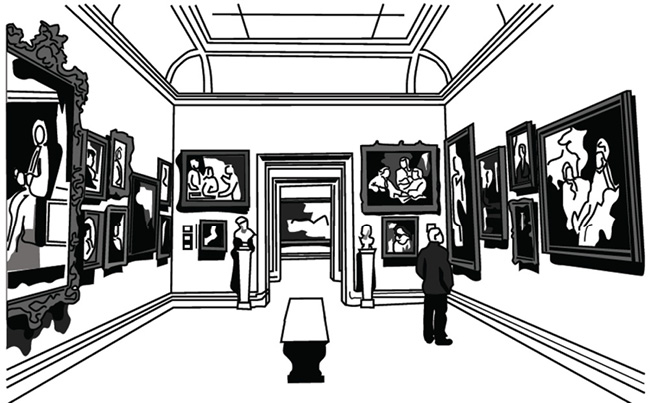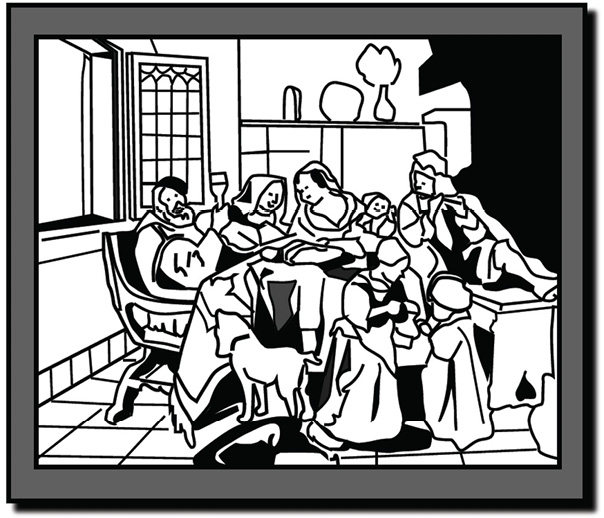The Art Gallery

Every year, the city gallery held an art exhibition, but I only remember one of them because it still haunts me. The exhibition presented a collection of famous paintings, old masters by painters who lived over four hundred years ago. I was dragged round it by Uncle Jim and my sister Kath because they were both crazy about art. I pretended to be interested in those old paintings, (though history was my least favourite subject). Can you imagine the scene in the gallery? There were crowds of people, walking round as slow as snails, taking ten minutes to study each painting. I was staring reluctantly at some old canvases, which portrayed strange people in weird, old-fashioned costumes. They were sitting in rooms as dark as pitch, full of antique furnishings. Through the windows of their houses, I saw a landscape stretching into nothingness, which consisted of green trees, rolling hills and a grey lake. Seriously, how could they lead a happy life in those places: with no technology, no cars, planes or computers? That’s why I stared blankly at each canvas, pretending to be interested, but thinking about the burger and chips they served in the restaurant.
I jumped the queue of art connoisseurs and wandered off on my own. Uncle Jim and Kathryn were being annoying, ambling round so slowly, commenting on every little detail in each painting. I wanted to move quickly, so I could get to the café. Anyway, what harm could come to me in here? I left the main hall and entered a small side room. Immediately, I sensed it had a mysterious atmosphere; it was strangely empty. There was only one painting on the end wall. The artist had painted a scene of a rich family, (a duke and duchess and their kids perhaps), eating a lavish feast. The food was set out on a huge table, lit by a giant candelabrum. The flickering flames of the candles lit up the pale, sad faces of the people at the table. It lit the faces of the musicians who were entertaining them. One man was dressed in a clown’s costume. Satisfied, that I had learnt enough about the life of these people, I turned to go.

At that moment, I heard a low voice. It was hardly audible, but it was calling my name. “Come closer Stephen”, it croaked like a toad. “I want to have a word with you.” I turned round, expecting to see the curator, but to my surprise there was no one there. Was the voice coming from the painting? NO of course not! I dismissed this crazy thought instantly, until I caught the eye of the ominous looking clown in the painting. He fixed his gaze on me. His mouth twitched. His thin bony finger beckoned me to come closer. In a mad moment, I went over to him and stared up into those sad, black eyes.
“I have a proposition to make to you boy. Yes, you down there.” I stared dumbfounded. “Why don’t we swap places, you and me? You can come into my seventeenth century world and wear this ridiculous costume and I’ll be a modern boy.” I stood speechless trying to grasp what was happening. Before I could reply, to my absolute horror, he started to move slowly, very slowly from his position, “No, no, no, I stammered… the modern world is stressful, there’s pollution... our technology breaks down... You’d need loads of money.” But, he was clambering down from the painting, reaching out for my arm to help him down. Suddenly, the movement caused the painting to tip. Then it crashed down. BANG! It fell on the floor. It smashed in several pieces. My head was spinning and I was falling, falling…
Alerted by the security alarm (that goes off automatically if a valuable painting is touched), the curator strolled briskly into the room, “What’s going on he demanded to know? That painting is priceless. How did it fall? I’ll call the police…” “It just fell off the wall,” insisted a man with a soft croaky voice, “and I think it may have bumped this young man.” I found myself sitting on the floor, dazed from a bump on my head. Uncle Jim and Kath were fussing over me; someone was applying first aid, “Are you sure you’re all right?” asked the soft voiced man, staring down at me with a weird expression. Was that a twinkle in his eye? He bore an uncanny resemblance to somebody familiar, but after the bump on my head I felt confused. “Who is he,” I pondered? I watched him leave by the exit and he went out into the real world.
A week later, I went back to the city gallery. In all that confusion at the art gallery, I’d mislaid both my jacket and rucksack. Had they turned up in lost property? No! There was definitely nothing of mine there. Browsing through the items, I couldn’t help be a little surprised at the kind of things people lose. Who would lose a strange fancy dress costume, a clown outfit for example? The mind boggles. By this time, the painting had been completely restored, with no signs of any damage. It had been re-hung and out of curiosity I went to look at it. It seemed totally different, I thought. It was fresher, less sinister. The people looked happier. Was one of the figures missing? It was all coming back to me now. Oh no! It couldn’t be… Could it?
Now, it is your turn to write a story about a picture in an art gallery. Write a follow up story about the clown who escaped from the painting. What happens to him when he goes out into the 21st century?
Don’t forget to STRUCTURE your story.
It means organise your story so it has a beginning, middle and end. Find out more about structuring a story.
1. How do I write a beginning or opening paragraph?
First, the writer chooses an opening sentence that will impact the reader and make him or her want to read on. It should be exciting, stimulating, thrilling, gripping and spine tingling. It should conjure up the atmosphere. In the first paragraph the writer must introduce the characters, the setting and the plot.
Alternatively, the writer could:
- start straight into the action
- introduce the characters and plot using dialogue.
- start by describing the setting.
I’ve written a good beginning. How do I continue my story?
2. What do I put in the middle paragraph(s)?
Now develop the plot of the story. Are things going well in your story? Introduce a complication in the story line - a problem - a mystery - something the characters have to overcome. Move the events on at a fast pace. If there is lots of action, it will be exciting for your reader, so he or she is eager to see what happens next.
3. What is building up suspense?
Keep building up suspense in your story. Towards the end of the second paragraph, your main character is in some danger. He or she is in a difficult situation. What will happen? Will he survive? Use short statements. Use ! or ? or words like ‘suddenly’. Your reader must be gripped by fear - suspense - excitement - doubt or anger. This is the climax. Your reader will want to know how the story will end.
4. What do I put in the ending or resolution?
You must have a good ending or resolution. In the last paragraph,
you must wind up events with a satisfactory conclusion.
- It might be a happy ending - where characters live happily ever after.
- A surprise cliffhanger ending - where the reader has to draw his or her own conclusion about what really happens.
- It might be a sad ending or a moral ending - with a comment from the author, ‘It taught me never to go off on my own again.’
Whatever ending you decide on, make the last line memorable for
your reader.
Now write the story you planned.